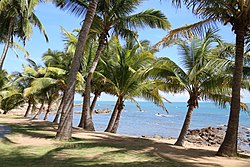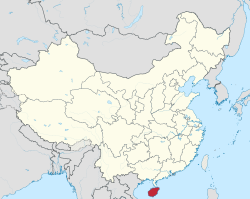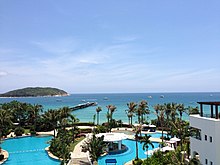A | B | C | D | E | F | G | H | CH | I | J | K | L | M | N | O | P | Q | R | S | T | U | V | W | X | Y | Z | 0 | 1 | 2 | 3 | 4 | 5 | 6 | 7 | 8 | 9
Hainan
海南 | |
|---|---|
| Name transcription(s) | |
| • Chinese | 海南省 (Hǎinán Shěng) |
| • Hainanese | Hái-nâm-séng |
| • Cantonese Jyutping | Hoi2naam4 Saang2 |
| • Abbreviation | 琼 (Qióng / Khêng / King4) |
 Sanya Nanshan Dongtian Park | |
 Location of Hainan within China | |
| Coordinates: 19°12′N 109°42′E / 19.2°N 109.7°E | |
| Country | China |
| Guangnan West Circuit | 988 |
| Hainan Special Administrative Region | 1944 |
| Incorporation into the PRC | 1 May 1950 |
| Separation from Guangdong | 26 April 1988 |
| Capital and largest city | Haikou |
| Divisions | 4 prefectures, 25 counties, 218 townships |
| Government | |
| • Type | Province |
| • Body | Hainan Provincial People's Congress |
| • CCP Secretary | Feng Fei |
| • Congress Chairman | Feng Fei |
| • Governor | Liu Xiaoming |
| • CPPCC Chairman | Li Rongcan |
| Area | |
| • Total | 35,191 km2 (13,587 sq mi) |
| • Rank | 28th |
| Highest elevation | 1,840 m (6,040 ft) |
| Population (2020)[2] | |
| • Total | 10,081,232 |
| • Rank | 28th |
| • Density | 290/km2 (740/sq mi) |
| • Rank | 17th |
| Demographics | |
| • Ethnic composition | Han: 82.6% Li: 15.84% Miao: 0.82% Zhuang: 0.67% |
| • Languages and dialects | Standard Chinese, Hainanese, Yue, Lingao, Hakka, Hlai, Miao, Tsat |
| ISO 3166 code | CN-HI |
| GDP (2021) | CN¥647.52 billion US$100.39 billion (31st)[3] |
| GDP per capita | CN¥64,230 US$9,958 (25th) |
| GDP growth | |
| HDI (2018) | 0.750[4] (high) (19th) |
| Website | English Chinese |
Native name: 海南岛 | |
|---|---|
 | |
| Geography | |
| Location | East Asia |
| Type | Island |
| Area | 33,210 km2 (12,820 sq mi) |
| Area rank | 42nd |
| Length | 156 km (96.9 mi) |
| Width | 170 km (106 mi) |
| Highest elevation | 1,840 m (6040 ft) |
| Highest point | Wuzhi Mountain |
| Administration | |
People's Republic of China | |
| Province | Hainan |
| Largest settlement | Haikou (pop. 2,873,358) |
Republic of China (claimed) | |
| Special Administrative Region | Hainan |
| Demographics | |
| Population | c. 8,180,000 |
| Ethnic groups | Han, Li, Miao, Zhuang, Utsul |
| Hainan | |||||||||||||||||||||||||||||||||
|---|---|---|---|---|---|---|---|---|---|---|---|---|---|---|---|---|---|---|---|---|---|---|---|---|---|---|---|---|---|---|---|---|---|
 "Hainan" in Chinese characters | |||||||||||||||||||||||||||||||||
| Chinese | 海南 | ||||||||||||||||||||||||||||||||
| Literal meaning | "South of the Sea (Qiongzhou Strait)" | ||||||||||||||||||||||||||||||||
| |||||||||||||||||||||||||||||||||
| Former names | |||||||
|---|---|---|---|---|---|---|---|
| Zhuya | |||||||
| Chinese | 珠崖 | ||||||
| Literal meaning | Pearl Cliffs | ||||||
| |||||||
| Qiongya | |||||||
| Traditional Chinese | 瓊崖 | ||||||
| Simplified Chinese | 琼崖 | ||||||
| Literal meaning | Jade Cliffs | ||||||
| |||||||
| Qiongzhou | |||||||
| Traditional Chinese | 瓊州 | ||||||
| Simplified Chinese | 琼州 | ||||||
| Literal meaning | Jade Prefecture | ||||||
| |||||||
Hainan (UK: /haɪˈnæn/, US: /-nɑːn/;[5] Chinese: ![]() 海南) is the smallest and southernmost province of the People's Republic of China (PRC), consisting of various islands in the South China Sea. Hainan Island, the largest and most populous island in China,[note 1] makes up the vast majority (97%) of the province. The name means "south of the sea", reflecting the island's position south of the Qiongzhou Strait, which separates it from Leizhou Peninsula and the Chinese mainland.
海南) is the smallest and southernmost province of the People's Republic of China (PRC), consisting of various islands in the South China Sea. Hainan Island, the largest and most populous island in China,[note 1] makes up the vast majority (97%) of the province. The name means "south of the sea", reflecting the island's position south of the Qiongzhou Strait, which separates it from Leizhou Peninsula and the Chinese mainland.
The province has a land area of 33,920 square kilometers (13,100 sq mi), of which Hainan Island is 32,900 square kilometers (12,700 sq mi) and the rest is over 200 islands scattered across three archipelagos: Zhongsha, Xisha and Nansha. It was part of Guangdong from 1950 to 1988, after which it was made a province of its own and was designated as a special economic zone by Deng Xiaoping, as part of the Chinese economic reform program.
Indigenous peoples like the Hlai, a Kra–Dai-speaking ethnic group, are native to the island and compose 15% of the population. Their native languages include the Hlai languages. The Hlai are recognized by the Chinese government as one of the country's 56 ethnic groups. The Chinese population, who compose a majority of the population at 82%, speak a wide variety of languages including Standard Chinese, Hainam Min, Yue Chinese, Cantonese, Hakka Chinese, etc.[6] Speakers of Be, despite speaking a Kra-Dai language, are reckoned officially as ethnically Chinese. Hainan is also home to the Jiamao language, of disputed provenance.
There are ten major cities and ten counties in Hainan Province. The capital of the province is Haikou, on the northern coast of Hainan Island, while Sanya is a well-known tourist destination on the southern coast. The other major cities are Wenchang, Sansha, Qionghai, Wanning, Wuzhishan, Dongfang and Danzhou.
According to China's territorial claims, several disputed territories in the South China Sea, including the Spratly Islands (Nansha) and Paracel Islands (Xisha),[7] are administered under Sansha city of the province. However, many of these islands are also claimed and de facto controlled by other countries, such as Philippines and Vietnam.[8]
In 2020, a large-scale plan was announced by the Chinese government to transform the entire island province into a free trade port, with the aim of turning it into the largest free-trade port in the world by 2035. The plan involves building a hub for offshore financing and duty-free shopping, as well as using lower taxes and reduced visa requirements to help draw in foreign businesses and tourists. Moreover, all goods sold from Hainan to other parts of China would be treated as imports from 2025 onward.[9][10][11][12]
Names
The provincial name derives from its major island, Hainan, in Hainanese "Hai Nam", which is named after its position south of the Qiongzhou Strait. (To the north of the strait, the Leizhou Peninsula in Guangdong is also known as Haibei/Hai Bac or "North of the Sea".) Former names for Hainan Island include Zhuya, Qiongya, and Qiongzhou. The latter two gave rise to the provincial abbreviation 瓊 or 琼 (Qióng/Kheng).
During the 17th and 18th centuries, explorers referred to the island as "Aynam",[13][14] which remains the pronunciation of its name in the local Hainanese dialect.
History

Prehistoric era
According to some scholars, Hainan was originally attached to the Northeastern part of what is now Vietnam; however, the island was formed after it physically broke away from Vietnam due to a volcanic eruption and drifted southeast near China after the Mesozoic, millions of years ago.[15]
The Baiyue people are among the earliest Kra-Dai residents to arrive on Hainan island. They are believed to have settled there at least 2 to 6 thousand years ago, and carry genetic markers from ancient people who reached the island between 7 and 27 thousand years ago.[16]
Imperial Era
Hainan Island was recorded by Chinese mandarin officials in 110 BC, when the Han dynasty of China established a military garrison there following the arrival of General Lu Bode. Han citizens, including military personnel and civil servants began to migrate to Hainan Island from the mainland. For centuries, imperial courts exiled criminals and political dissidents to Hainan island and what is now northern Vietnam, both of which were parts of Guangdong province most of the time during various Chinese dynasties, to toil under the tropical heat. One of the most famous exiled persons is Su Shi, an intellectual, gifted poet, and Song dynasty bureaucrat, who offended many of his colleagues and superiors in the royal court. Su Shi wrote extensively about his exiled experiences on the island during the 11th century AD. After the 11th century AD, more and more poor peasants looked for land and moved from other parts of the Guangdong province to Leizhou peninsula and Hainan island, pushing the indigenous Li people, one of the various Bai-Yue tribes in southern China, into the highlands of the southern half of the island.
Republic of China
Hainan was historically part of Guangdong and Guangxi Provinces and as such was the Qiongya Circuit (瓊崖道) under the 1912 establishment of the Republic of China. In 1921, it was planned to become a special administrative region (瓊崖特別行政區); in 1944, it became Hainan Special Administrative Region with 16 counties, including the South China Sea Islands.
During the 1920s and 30s, Hainan was a hotbed of banditry, many opposition politicians[clarification needed] were hanged, therefore opposition politicians went into hiding. The Communists and the indigenous Hlai people fought a vigorous guerrilla campaign against the Japanese, who were only able to occupy some Hainan territories; but in retaliation the Japanese launched numerous massacres against Hlai villages. Feng Baiju led the Hainan Independent Column of fighters throughout the 1930s and 1940s. After the Japanese surrender in 1945, the Kuomintang reestablished control. Hainan was one of the last areas to eventually come under the administration of the People's Republic, having been under the control of ROC forces until March 1950. The People's Republic attacked Hainan on 10 April 1950 and attained complete control on 1 May.
People's Republic of China

On 1 May 1950, under the People's Republic of China, the Hainan Special Administrative Region became an Administrative Region Office (海南行政区公署), a branch of the Guangdong provincial government. During the mid-1980s, when Hainan Island was still part of Guangdong Province, a fourteen-month episode of marketing zeal by Hainan Special District Administrator Lei Yu[17] put Hainan's pursuit of provincial status under a cloud. It involved the duty-free imports from Hong Kong of 90,000 Japanese-made cars and trucks at a cost of ¥ 4.5 billion (US$1.5 billion), and exporting them – with the help of local naval units – to the mainland, making 150% profits. By comparison, only 10,000 vehicles were imported into Hainan since 1950. In addition, it involved further consignments of 2.9 million TV sets, 252,000 videocassette recorders & 122,000 motorcycles. The money was taken from the 1983 central government funds destined for the construction of the island's transportation infrastructure (roads, railways, airports, harbors) over the next ten years.[citation needed]
On 1 October 1984, it became the Hainan Administrative Region (海南行政区), with its own People's Government, and finally as a province separate from Guangdong four years later. In 1988, when the island was made a separate province, it was designated a Special Economic Zone in an effort to increase investment.
The central government funds were deemed insufficient by the Hainan authorities for the construction of the island's other infrastructure (e.g. water works, power stations, telecommunications) and had taken a very liberal interpretation of the economic and trade regulations for Hainan and thirteen coastal cities; the regulations did not mention on prohibiting the re-selling of second-hand goods. Some of the proceeds, from unsold units, were later retrieved by the central government to re-finance the special district.
In June 2020, China announced a master plan for Hainan's free trade port system. Announced by state-owned media Xinhua News Agency, Hainan will "basically establish a free trade port system by 2025 and become more mature by 2035."[18][19] South China Morning Post described such an initiative as an effort of PRC to "replace Hong Kong as the trading entrepôt" while Cheng Shi of ICBC International has refused to accept such a claim.[20][21] Additionally, experts have raised concerns about the question of compliance of global trading practices particularly for this project.[22][23]
Geography

Hainan, separated by the 20 km (12 mi) wide Qiongzhou Strait from the Leizhou Peninsula of Guangdong, is the largest island administered by the People's Republic of China and the 42nd largest in the world. The area of Hainan Island (32,900 km2 (12,700 sq mi), 97% of the province) is slightly smaller than that of Taiwan Island. To the west of Hainan Island is the Gulf of Tonkin. Wuzhi Mountain is the highest mountain on the island at 1,840 m (6,040 ft).
Hainan Island measures 288 km (179 mi) long and 180 km (110 mi) wide.
The northern half of Hainan is covered with the ancient Hainan Volcanic Field. Beneath the topsoil is volcanic rock while the topsoil itself contains small pieces of this vesicular rock.
Wetland covers 320,000 hectares, 78,000 hectares of which were created artificially. Most of this is located in the eastern and northern part of Hainan.[24]
Rivers and lakes
Most of the rivers in Hainan originate in the central area of the island and flow radially in different directions. The Nandu River in the northern part of the island is 314 km (195 mi) long, and its tributary, the Xinwu River, is 109 km (68 mi) long. Other major rivers include the Wanquan River at 162 km (101 mi)-long in the east, Changhua River in the west, and the Sanya and Taiyang Rivers in the south. Evaporation during the dry season around the coastal areas greatly reduces the flow of the rivers.
There are very few natural lakes in Hainan. However, there are numerous reservoirs, the largest of which is the Songtao Reservoir in the central-north area.
Islands
Nearby islands
Several small islands exist around the coast of Hainan Island:
- Dazhou Island is located about 5 km (3.1 mi) off the coast of Wanning
- Haidian Island, on the north coast, is part of Haikou City
- Nanwan Monkey Island, in actuality a peninsula
- Phoenix Island is an artificial resort island currently under construction in Sanya Bay.
- Wuzhizhou Island is located within Haitang Bay
- Xinbu Island is located directly to the east of Haidian Island
Due to their close proximity to the main island, the flora, fauna, and the climate are very similar.
Disputed islands

A number of small islands, which are located hundreds of kilometers to the south, are claimed and administered by Sansha as part of Hainan Province.[25] Sovereignty of these islands is however disputed. These islands include:
- Paracel Islands Xisha Islands – "The West-sands" – claimed by Vietnam, the PRC and the Republic of China (Taiwan, ROC)
- Zhongsha Islands – "The Middle-sands"
- Spratly Islands – Nansha Islands – "The South-sands" are subject to claims by Vietnam, the PRC, ROC, Malaysia, the Philippines, and Brunei.
Environment
Compared to most of mainland China, the air quality of Hainan is significantly better since it is not affected by factory pollution, which has adversely affected the air on the mainland. Throughout 2012, Hainan had the highest air quality in the country for 351 days.[citation needed]
The provincial government's environmental protection campaign has taken action against a number of industrial plants. During 2012, several outdated manufacturing facilities had their business licenses revoked, and 175 cases related to illegal sewage discharge were handled.[citation needed]
Total sulfur dioxide emissions for the province were 34,000 tons in 2012, a 3 percent year-on-year reduction. In 2011, smog emissions were reduced 6.3 percent to 15,000 tons.[citation needed]
Climate
| Hainan Island | ||||||||||||||||||||
|---|---|---|---|---|---|---|---|---|---|---|---|---|---|---|---|---|---|---|---|---|
| Climate chart (explanation) | ||||||||||||||||||||
|


